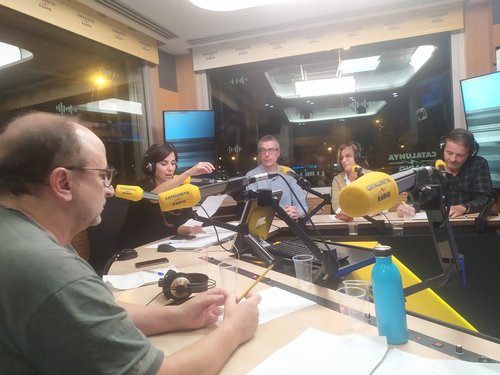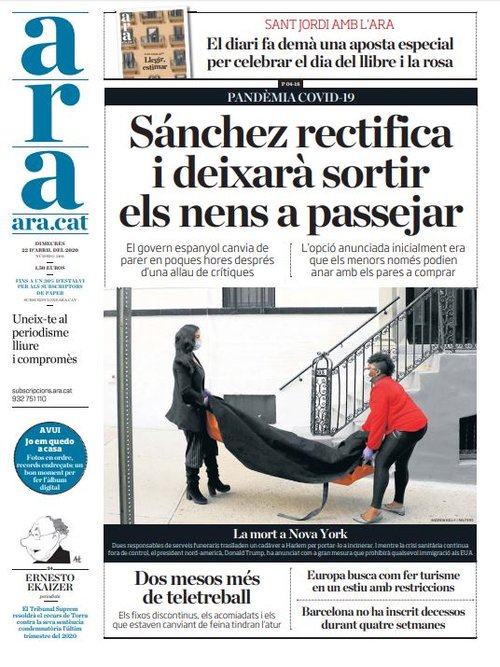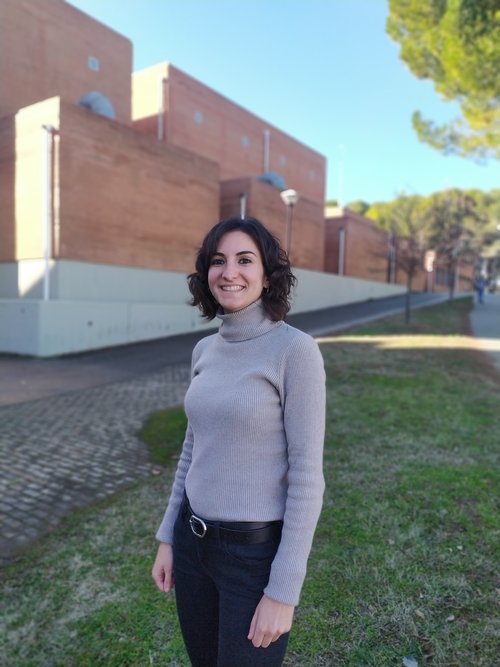Minority language media and the COVID-19 pandemic – the case of Catalan in Spain. An interview with Prof. Dr. Aida Martori Muntsant.





A series edited and conceptualised by Dr. Sergiusz Bober and Craig Willis.
Our fifth interview on minority language media (MLM) during the ongoing COVID-19 pandemic focuses again on a case in Spain, with Prof. Dr. Aida Martori Muntsant (Universitat Autònoma de Barcelona) discussing the situation of Catalan language media in Catalonia. An MLM sphere with a substantial array of institutions including many local TV and radio stations as well as and print and online newspapers, the situation for Catalan media was nonetheless greatly affected by the pandemic. The aspect of rising audience numbers alongside falling revenue, seen in many MLM situations already in this series, is also present in the Catalan case. Martori Mutsant details this as well as the impact on content and the logistic issues which a strict lockdown situation presented. This includes positive examples of specific TV shows created to give voice in Catalan to different people affected by the pandemic, but also more troubling aspects such as a concern of introducing Spanish language on Catalan public service media, or issues of fake news spread on social media, and of course the financial issues presented by lower advertising revenues.
As usual, the interview begins with a detailed overview of the existing situation of MLM, where Prof. Dr. Aida Martori Muntsant shows the depth of media in Catalan across many forms, both in the public and private sector.
As an introduction, could you please summarise the minority language media (MLM) situation in your linguistic sphere?
In terms of traditional media, in Catalonia there are good quality Catalan-language media although the number of Spanish ones is larger in the media system. According to the Catalan Audiovisual Council (CAC), the regulatory agency, there are 9 Catalan-language television channels (5 public and 4 commercial, such as TV3 or 8TV) as opposed to 32 channels broadcasting in Spanish (7 public and 25 commercial, for example Telecinco or Antena3). Referring to radio stations, there are 12 Catalan (4 public and 8 commercial, such as Catalunya Ràdio or RAC1) and 19 Spanish (5 public and 14 commercial, for example Cadena SER or COPE). Despite the unequal number of broadcasters, the leadership in audiences is dominated by Catalan media in both cases. Public service media (PSM) develops an important role in spreading the use and normalizing the Catalan language.
The consumption of print press is mainly focused on newspapers produced in Catalonia, although the two most-widely distributed ones, La Vanguardia and El Periódico have editions in both languages (Catalan and Spanish). Regarding online newspapers, those with most users in Catalonia are published in Catalan.
Moreover, Catalonia is a paradigmatic case due to a large number of local media outlets. According to CAC, there are 51 local television channels and 231 local radio stations. The list includes public and commercial broadcasters, but there are also non-profit projects that have to be taken into consideration (a 2017 research project identified 16 channels that were broadcasting on and off line, apart from the official list, most of them managed by organizations of the third sector). The Catalan Association of Local Press includes 138 local newspapers and magazines (printed and digital).
How has the COVID-19 pandemic affected the reporting of the MLM in your area and has there been any effect on readership / viewing figures?
During the mandatory confinement due to the COVID-19 pandemic, data shows that television consumption in Catalonia grew up 1 hour a day per citizen. The crisis reinforced the role of the public service channel TV3 (which broadcasts almost exclusively in Catalan) as the main source of information. According to a survey, 2/3 of citizens perceived TV3 as the most reliable source of information to receive news about the sanitary situation, and the second most trustworthy media in Catalonia is the public radio. Moreover, the consumption of non-linear PSM services increased: online users and video consumption through the websites reached the highest rate ever. This information shows the good work of PSM during the pandemic although the economic resources of the public media corporation were reduced especially due to the decrease of advertising.
In general, the consumption of information by the audience increased, also through private media, but incomes of commercial media fell dramatically down, putting them in a dangerous situation in terms of viability, and provoking some readjustments in companies (sometimes affecting the number of workers). Measures announced by the Catalan government in July are focused on a line of credit to provide cash flow to press companies.
How has the lockdown / social distancing measures affected other covered content in MLM?
During the lockdown, newscasts were focusing their attention on the COVID-19 crisis, almost exclusively. During the peak of the pandemic most media (including the Catalan PSM) provided updated information on the COVID-19 situation and entertainment was rarely present in the programming (in fact, ongoing projects were stopped because of the social distancing, such as the soap opera Com si fos ahir or the documentary La Flota d'Índies).
Initially, some media adopted the military language that was used especially by the Spanish government, but critical voices raised issues with this and there were media that avoided reproducing these expressions (as well as politicians reducing the use of language that could evoke a conflict period).
PSM worked with less staff and used measures of protection; only entering hospitals or residential homes when it was necessary and with a lot of precaution – usually only for in-depth reporting. Sometimes journalists were informing, offering analysis or following press conferences from home via video-conferences.
Progressively, media were incorporating other content in the schedule, and PSM offered in-depth information of how COVID-19 was affecting different sectors of society (instead of providing only the breaking news or data). For example, the public television channel TV3 created the program Primera línia that gave voice to citizens working or volunteering in different sectors to let them explaining how was their everyday life being adapted to the situation caused by the pandemic. Also reports looking at different affectations of COVID-19 were broadcast, as well as little entertainment shows that were re-emitted.
How has MLM covered issues of majority-minority relations and has the situation or voice of minorities been covered in majority media?
For more than 3 months, the COVID-19 crisis was managed entirely by the Spanish government, after the state of emergency was declared. The Health Ministry was the only competent authority to command the crisis and make decisions, although the Catalan government claimed to maintain competences. In that context, politicians in Catalonia had no powers to introduce mandatory measures to the citizens. However, Catalan ministers made recommendations and organized press conferences with journalists (usually virtual), and they announced measures that they would propose to the Spanish government to be adopted. Moreover, every Sunday there was the autonomous presidents conference with the Prime Minister of Spain and the presidents of every Autonomous Community, including Catalonia.
MLM covered both the press conferences and announcements from the Catalan government (even without competences to make mandatory decisions), and the evolution of the relationship between the Catalan and the Spanish government (there was tension between the two governments because of the Spanish centralized management of the crisis -in which the Catalan part did not agree- that added to the already existing tensions due to the “Catalan independence process”). Moreover, MLM covered the situation of the health crisis especially in Catalonia, also taking into account the Spanish situation and comparing data provided from the two governments.
In what way has the pandemic affected MLM practitioners’ day to day work and have there been any future implications discussed?
The pandemic affected MLM practitioners in different aspects:
The reduction of the number of staff working in the headquarters during many weeks (the peak of the crisis). Media were operating with less on-site staff. All employees that could work at home were doing their job online (producers, social networks specialists, etc.). Moreover, all non-essential staff (such us make-up artists, stylists, etc.) were not attending their workplaces, to avoid taking risks.
There was a reduction of journalists working off set.
When media professionals had to work in the street or other spaces, they adopted measures of protection.
Panel members or analysts in programmes were joining through online connections from home.
Several private media adopted measures to temporarily reduce their personnel.
Commercial media were working hard to provide information on the pandemic, but at the same time advertising (and thus revenues) dramatically fell. For example, digital media in Anoia (the first region that was in lockdown in Catalonia) had more clicks than ever on their websites but at the same time the budget of the projects were in negative figures because of the reduction of commercial clients.
The reduction of advertisement also affected public media: the director of TV3 announced that some entertainment productions were put in stand-by and only could re-start if the economic situation become better in the following months.
How has social media in minority language played a role during the pandemic?
Citizens are very active in social networks, commenting on the situation, criticizing politicians or the measures taken by the government – the Spanish or Catalan – (for example, the cultural sector were actively showing their concerns about stopping such activity) or expressing their feelings. Also, institutions sent official recommendations through social networks and there were scientists showing their opinions publicly through social networks, especially Twitter (such us the expert in epidemiology Dr. Oriol Mitjà or the physician Dr. Alex Arenas).
However, whereas media in general provided reliable information, on social media networks trust and fake news were combined. There was a case of an audio file spread via WhatsApp allegedly from an employee of a Catalan company informing that the Spanish government refused to standardize a respirator for hospitals that they could produce. Individual users were spreading the news without checking if the information was trustworthy or even who was the author of the message. After the dissemination of this message through mobile devices, the public radio station, Catalunya Ràdio, decided to research the issue in order to verify (or not) the information, and to accurately inform about the issue. Catalunya Ràdio has a section, called ‘Fets o fakes’ (Facts or fakes), in order to verify information that could be falsely or mistakenly spread.
Because of the risk of anxiety resulting from a continuous exposure to information concerning the public health situation, the high number of hours that citizens spend in front of a screen, and the proliferation of fake news, the Catalan Audiovisual Council elaborated recommendations to give tools to the public to verify information before sharing it.
Are there any other points, observations, or impressions of relevance for MLM in the context of COVID-19 you would like to share?
First, I would like to point out that the COVID-19 situation resulted in the paradox of having a high number of readers/viewers/listeners whereas the income of commercial (but also public) media outlets was decreasing. Regarding this situation, some debates arise such as on the consumption of free information, and whether there is access to reliable information.
Secondly, in Catalonia there is a concern about the decrease of the Catalan PSM capacity to produce new content. This situation is a threat for the representation of the Catalan language on the media and for the Catalan audiovisual industry. Another issue under debate is the use of Catalan-language in public television because of a series broadcasted, in which Catalan and Spanish language were combined (a situation that rarely takes place in TV3, because the content is mainly in Catalan). Part of society was afraid of introducing Spanish in the few only-Catalan media spaces, as the public broadcaster.
Thirdly, I would like to point out that whereas the MLM ecosystem is quite good in traditional media, the Catalan language in the digital environment is less “robust”. The availability of Catalan content on the Internet and social networks is an outstanding issue. There have been complaints about the lack of a structure that allows the creation and dissemination of digital content on the Internet with visibility, and the lack of references on the Internet for children and young people in Catalan. For this reason, we have recently seen the emergence of initiatives such as Canal Malaia to promote the creation of online content. The aim of the project, created by a group of young people with knowledge of the online dynamics and the objective of change this situation, is to look for “untapped talent” and to establish a network to position it and facilitate that Catalan digital content reaches the viewer.
Finally, some voices in academia and in the media sector (such as the association of audiovisual producers) call for an OTT platform that can bring together the public and private sectors to develop a powerful audiovisual structure to encourage and facilitate content production in Catalonia.
About the author:
Aida Martori Muntsant has a PhD in Communications from the Universitat Autonoma de Barcelona (UAB), that received the Extraordinary Doctorate Award and a recognition from the Catalan Audiovisual Council. She was visiting scholar at the Centre for Cultural Policy Research (CCPR) at the University of Glasgow and at the Institute of Communication Research (ICR) at the University of Illinois at Urbana-Champaign, and she was visiting professor at the Bezalel Academy of Arts and Design in Jerusalem. Martori published in journals and presented her projects in internationals conferences. Her research has been mainly focused on Public Service Media, local media and digitalization. She is currently member of the Daniel Jones research group (UAB), she is participating in a R&D project funded by the Spanish government and she recently obtained the Local Press Research Award. Martori is professor at UAB and Tecnocampus, and combines her academic career with collaborations in Catalan media.




Commentaries
If you wish to write a commentary on this interview, please contact the editors Dr. Sergiusz Bober and Craig Willis.

